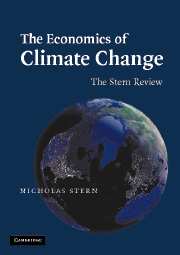Book contents
- Frontmatter
- Contents
- Preface
- Acknowledgements
- Introduction
- Summary of Conclusions
- Part I Climate Change – Our Approach
- Part II Impacts of Climate Change on Growth and Development
- Part III The Economics of Stabilisation
- 7 Projecting the Growth of Greenhouse-Gas Emissions
- 7A Climate Change and the Environmental Kuznets Curve
- 8 The Challenge of Stabilisation
- 9 Identifying the Costs of Mitigation
- 10 Macroeconomic Models of Costs
- 11 Structural Change and Competitiveness
- 11A Key Statistics for 123 UK Production Sectors
- 12 Opportunities and Wider Benefits from Climate Policies
- 13 Towards a Goal for Climate-Change Policy
- Part IV Policy Responses for Mitigation
- Part V Policy Responses for Adaptation
- Part VI International Collective Action
- Abbreviations and Acronyms
- Postscript
- Technical Annex to Postscript
- Index
7 - Projecting the Growth of Greenhouse-Gas Emissions
Published online by Cambridge University Press: 05 March 2014
- Frontmatter
- Contents
- Preface
- Acknowledgements
- Introduction
- Summary of Conclusions
- Part I Climate Change – Our Approach
- Part II Impacts of Climate Change on Growth and Development
- Part III The Economics of Stabilisation
- 7 Projecting the Growth of Greenhouse-Gas Emissions
- 7A Climate Change and the Environmental Kuznets Curve
- 8 The Challenge of Stabilisation
- 9 Identifying the Costs of Mitigation
- 10 Macroeconomic Models of Costs
- 11 Structural Change and Competitiveness
- 11A Key Statistics for 123 UK Production Sectors
- 12 Opportunities and Wider Benefits from Climate Policies
- 13 Towards a Goal for Climate-Change Policy
- Part IV Policy Responses for Mitigation
- Part V Policy Responses for Adaptation
- Part VI International Collective Action
- Abbreviations and Acronyms
- Postscript
- Technical Annex to Postscript
- Index
Summary
KEY MESSAGES
Greenhouse-gas concentrations in the atmosphere now stand at around 430 ppm CO2 equivalent, compared with only 280 ppm before the Industrial Revolution. The stock is rising, driven by increasing emissions from human activities, including energy generation and land-use change.
Emissions have been driven by economic development. CO2 emissions per head have been strongly correlated with GDP per head across time and countries. North America and Europe have produced around 70% of CO2 emissions from energy production since 1850, while developing countries – non-Annex 1 parties under the Kyoto Protocol – account for less than one quarter of cumulative emissions.
Annual emissions are still rising. Emissions of carbon dioxide, which accounts for the largest share of greenhouse gases, grew at an average annual rate of around 2½% between 1950 and 2000. In 2000, emissions of all greenhouse gases were around 42GtCO2e, increasing concentrations at a rate of about 2.7 ppm CO2e per year.
Without action to combat climate change, atmospheric concentrations of greenhouse gases will continue to rise. In a plausible ‘business as usual’ scenario, they will reach 550 ppm CO2e by 2035, then increasing at 4½ppm per year and still accelerating.
Most future emissions growth will come from today's developing countries, because of more rapid population and GDP growth than developed countries, and an increasing share of energy-intensive industries. The non-Annex 1 parties are likely to account for over three quarters of the increase in energy-related CO2 emissions between 2004 and 2030, according to the International Energy Agency, with China alone accounting for over one third of the increase.
- Type
- Chapter
- Information
- The Economics of Climate ChangeThe Stern Review, pp. 193 - 215Publisher: Cambridge University PressPrint publication year: 2007



